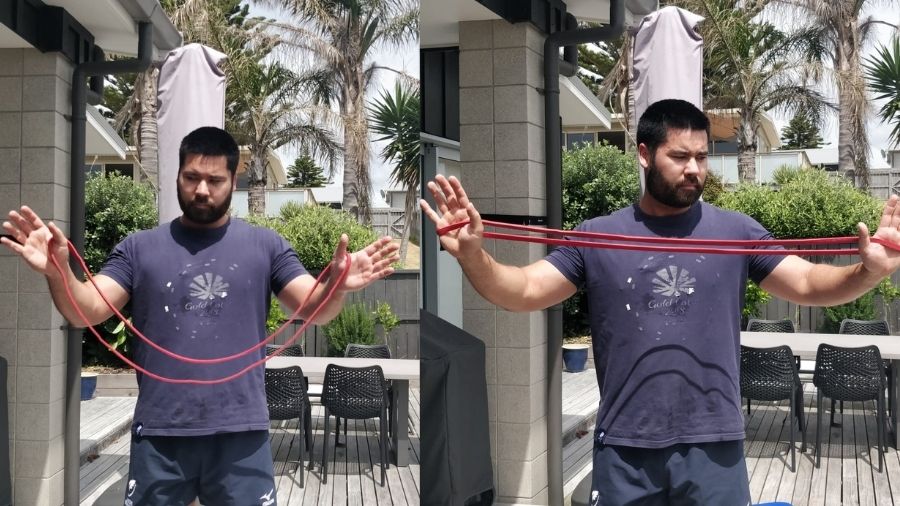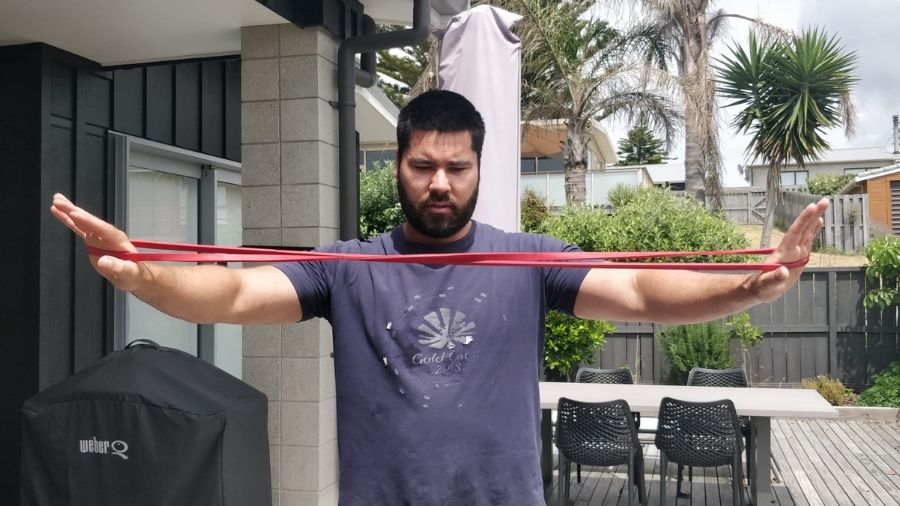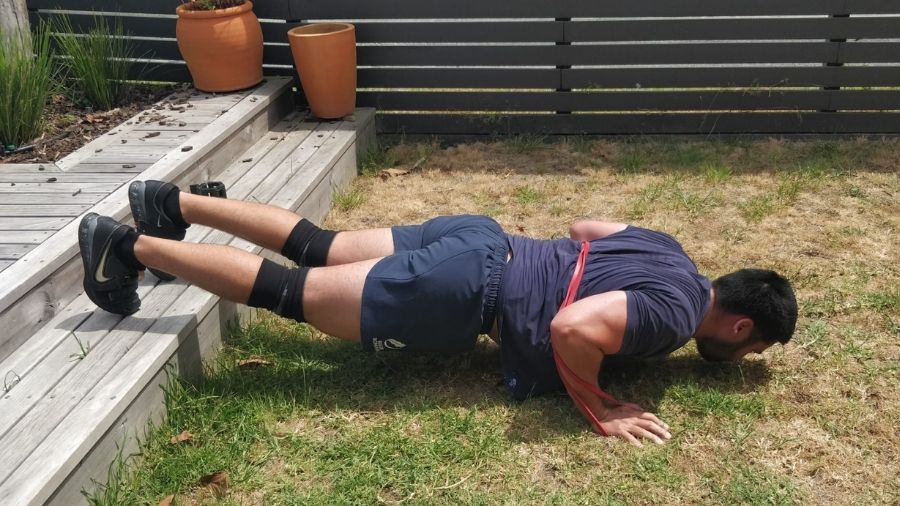The push-up is a staple upper body exercise for physical fitness tests and general muscle size and strength. However, they can get easy. And boring. Especially when you can do 20 or more reps in a single set without breaking a sweat, but there’s a simple solution to this.
Resistance band push-ups change the strength curve to challenge your muscles where they are strongest, resulting in greater force production and muscle growth of the upper body muscles.
If resistance band push-ups are great for mass, what size band should you use, and how do you do them effectively?
Table of Contents
- What Muscles Does The Resistance Band Push-Up Work?
- What Size Resistance Band For Push-Ups?
- How Do Resistance Bands Affect The Push-Up?
- Resistance Band Push-Ups vs. Bench Press
- How To Do The Resistance Band Push-Up For Mass
- Resistance Band Push-Up Variations
- Should You Use Resistance Band Push-Ups For Mass?
- Frequently Asked Questions
What Muscles Does The Resistance Band Push-Up Work?
The muscles worked during the resistance band push-up are similar to that of a regular push-up: namely, the pecs (chest muscles), shoulders, and triceps. But push-ups also activate the muscles of the trunk, such as the rectus abdominis and erector spinae, and involve the traps [1].
Specifically, the regular push-up heavily activate the shoulders compared to other push-up variations [1]. Interestingly, however, elevating the feet allows you to produce more force when performing the push-up likely due to more significant bodyweight supported by the arms [2].
Therefore, we can infer that resistance band push-ups allow more force to be produced by the pecs, shoulders, and triceps than regular push-ups.
What Size Resistance Band For Push-Ups?

The size of the resistance band you use for push-ups depends on your current level of strength. A general guideline would be if you can perform ten push-ups, use a thin resistance band (red shown in the picture).
If you can perform 15-20 push-ups, use a medium resistance band (purple shown in the picture). If you can complete more than 20 push-ups, you can double up bands to further increase the resistance.
How Do Resistance Bands Affect The Push-Up?
Let’s take a look at the strength curve of the push-up. The most challenging portion is at the bottom position. The push-up gets easier as you get closer to the top position with the arms fully extended. By adding bands, you change this strength curve where the bottom position is easier due to being unloaded.
As you push up, the exercise gets more challenging as the load increases with the stretch of the band. This means you challenge your muscles not only when they are stretched but also when they are in their strongest position (approximately halfway up).
Resistance Band Push-Ups vs. Bench Press
The muscles worked, and muscle activation is very similar between the resistance band push-up and the bench press [3]. However, rectus abdominis activation is 50% greater during the push-up than the bench press [4].
Interestingly, you can perform many more push-up reps when the load is the same as the bench press [5]. Approximately 13 more, to be exact. It has been suggested that this is because of the greater rectus abdominis activation during the push-up where narrow and middle grip bench presses (as per these studies) show greater shoulder activation [4].
This activation of the core muscles during the resistance band push-up may reduce the necessary activation from the main upper body muscles.
How To Do The Resistance Band Push-Up For Mass
I will take you through a step-by-step tutorial of how to perform the resistance band push-up without a frustrating setup process.
Step 1

Decide how you are going to wrap the band around your hands. You can either loop it around your thumb or your palm. My preference is the palm. If you are using a moderate-sized band and higher, looping it around your thumb becomes painful.
If you are using a small band, then looping it around your thumb is fine, but it pays to get used to having the band around your palm.
Step 2

Cross the band into an X. This pro tip will stop the band from flying up behind your neck when doing the resistance band push-up.
Step 3

Place the band around your back with it loop around your palms.
Step 4

Kneel down and get into the push-up position. You should feel like the band will stay in place when you start the push-up. If not, sit on your knees and adjust it until you feel comfortable.
Step 5

Perform the resistance band push-up as you would the regular push-up with the thumbs directly under the shoulders or slightly outside shoulder width. The elbows should form a 45° angle to the body. Elbows flared out to the side will wreck your shoulders and are a weaker position to push from.
Resistance Band Push-Up Variations
The resistance band push-up is very versatile in that you’re not stuck with the push-up on the floor. You can make the exercise harder or easier, depending on your goals.
Decline Resistance Band Push-Ups

As mentioned earlier, elevating the feet allows the upper body muscles to produce more force [2]. More force means greater mechanical tension and, therefore, is likely to result in greater muscle growth [6].
With the added resistance from the band, you’ve now increased force generation even further, making it an excellent exercise for adding mass.
It can be a pain when performing the decline resistance band push-up with the band flying up to your neck. If you pin the band behind your elbows, you won’t have this problem.
Stretch Resistance Band Push-Ups
Mechanical tension isn’t only maximized through load. A more significant stretch and a greater range of motion will also increase tension on the muscle. Further, you are increasing time under tension which influences muscle growth.
This will place a greater emphasis on your pecs compared to a resistance band push-up on the floor. You don’t need to elevate your hands very high. Even just using weight places is enough to increase the range of motion substantially.
Band Assisted Push-Ups
The band-assisted push-up can be a way for beginners to develop the strength to perform a regular push-up. But it also makes the perfect upper body ballistic exercise. If you don’t have the space to throw a medicine ball, you can tie a band to the top of your power rack and use it to deload bodyweight.
Should You Use Resistance Band Push-Ups For Mass?
If you can bang out 20 or more push-ups with ease, then resistance band push-ups make a lot of sense to add mass to the upper body. It will challenge your pecs, shoulders, and triceps to a greater extent than a regular push-up.
Further, suppose you cannot bench press for whatever reason. In that case, the resistance band push-up is the perfect alternative for your heavy pressing exercise as part of your push day, upper body day, or as your push exercise during a full-body workout.
Frequently Asked Questions
Are Resistance Band Push-Ups Good?
Resistance band push-ups are great. Bands allow you to load a push-up safely and without the need of a training partner. When using weight plates, you need someone to place them on your back. With a resistance band, you can challenge your push-ups when on your own.
Do Resistance Bands Make Push-Ups Easier?
Resistance bands make push-ups harder when used the traditional way. That is with the band around your back. However, if you tie the band to the top of a power rack and loop it under your chest, it will make the push-up easier by deloading bodyweight.
References
1. Beach, T. A., Howarth, S. J., & Callaghan, J. P. (2008). Muscular contribution to low-back loading and stiffness during standard and suspended push-ups. Human Movement Science, 27(3), 457-472.
2. Ebben, W. P., Wurm, B., VanderZanden, T. L., Spadavecchia, M. L., Durocher, J. J., Bickham, C. T., & Petushek, E. J. (2011). Kinetic analysis of several variations of push-ups. The Journal of Strength & Conditioning Research, 25(10), 2891-2894.
3. van den Tillaar, R. (2019). Comparison of kinematics and muscle activation between push-up and bench press. Sports medicine international open, 3(03), E74-E81.
4. Gottschall, J. S., Hastings, B., & Becker, Z. (2018). Muscle activity patterns do not differ between push-up and bench press exercises. Journal of applied biomechanics, 34(6), 442-447.
5. Alizadeh, S., Machel Rayner, M., & Behm, D. G. (2020). Push-Ups vs. Bench Press Differences in Repetitions and Muscle Activation between Sexes. Journal of sports science & medicine, 19(2), 289.
6. Schoenfeld, B. J. (2010). The mechanisms of muscle hypertrophy and their application to resistance training. The Journal of Strength & Conditioning Research, 24(10), 2857-2872.
